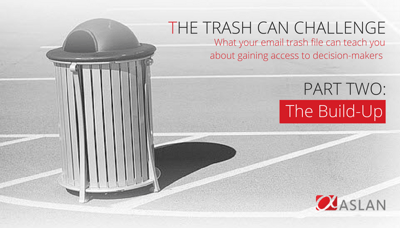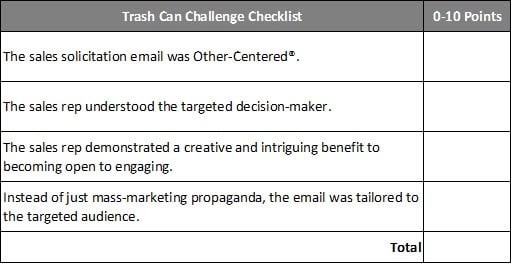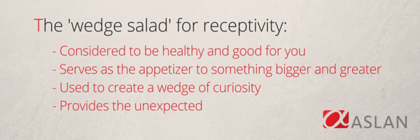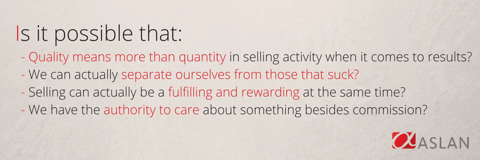‘The Trash Can Challenge’ for Sales Professionals - Part Two: The Build-Up
By Sean Robertson
July 28, 2016
10 min read
WHAT YOUR EMAIL TRASH FILE CAN TEACH YOU ABOUT GAINING ACCESS TO DECISION-MAKERS
“What you do speaks so loudly that I cannot hear what you say.”
- Ralph Waldo Emerson
Several years ago (back when I was half as old and twice as cool), I used to love going to the movies that had incredible sound quality and the THX opener – “The Audience is Listening.”
 The sound actually shook my popcorn and the room, and I always thought the “deep note” literally traveled in my right ear and came out my left. It basically meant that I needed to buckle my seatbelt because the sound quality was about to part my already great-looking hair for the next couple of hours.
The sound actually shook my popcorn and the room, and I always thought the “deep note” literally traveled in my right ear and came out my left. It basically meant that I needed to buckle my seatbelt because the sound quality was about to part my already great-looking hair for the next couple of hours.
In part one of the Trash Can series, we evaluated a portion of the current state of selling and the fact that much of the sales world is experiencing the opposite problem from that THX opener. The audience isn’t listening. And they may actually be wearing email ear muffs, at least as far as their communication is concerned.
The ambient noise that most sales people make today never even reaches the ear of the decision-maker. Decision-makers generally have an interest level somewhere less than zero for being pitched, prodded, or Power Pointed by sales reps, and yet thousands of people with business cards that read “sales consultant” keep using methods they have already proven don’t work. Isn’t there a word that describes what we are when we keep doing the same thing and expect different results?
In 'THE TRASH CAN CHALLENGE' FOR SALES PROFESSIONALS -PART ONE: THE BREAKDOWN we dissected this epidemic from an analytical perspective and challenged readers to conduct their own research. Now we are ready for some help-me sauce – the build-up. For those of you took the challenge and currently find yourself surrounded by a handful of Pulitzer Prize-winning examples of how to not get the decision-makers in your life to open up and become receptive to engaging with you, let’s help you start the shift, begin the restoration process, and get the audience listening.
The Build-Up
Here’s the truth. Most sales people have commission breath and would benefit from an Other-Centered® Altoid. Ralph Waldo Emerson said: “What you do speaks so loudly that I cannot hear what you say.” Am I the only one that thinks ‘ole Ralph might have just had a sales rep leave his office when he said this? And how is this relevant to the effort of attempting to engage decision-makers that are emotionally closed to being sold? How does this help us shift our focus to receptivity?
Let’s keep this simple. To make sure what we do actually helps our audience hear, we will focus on four elements to help you build an email (or voicemail) that demonstrates a noticeable shift away from selling and toward helping your audience become receptive. We will break down each of the Trash Can Challenge Checklist items to further assess what we have learned and find a few answers to help you shift to making sure your actions say what you want them to say.

Shift One: Take the “I” Exam
The most common discovery from the Trash Can Challenge is the use of a single letter – “I.” It’s such a simple word, and yet it’s one of the most lethal when it comes to the receptivity of your audience.
Does this look familiar to you?
“I’d like to see about getting on your calendar so I can learn about your company to see how I can be of service. Can I get 30 minutes so I can introduce you to my _____? I have worked with companies just like yours, and I am confident I can _____.”
Now let’s take the “I” exam (similar to an “eye exam” but intended to assess your vision and appetite for serving others). Based on the sentences above, it doesn’t take an ophthalmologist to see this person has 20/20 self-centered vision. There are three simple sentences and nine self-serving references. A decision-maker won’t need a set of reading glasses to read the underlying message in the approach and exactly who is being served.
Shift into Action:
How do you make sure you pass the “I” exam? Lose your “self.” Becoming Other-Centered begins with a choice. Because our tendency is to be self-centered first, we have to consciously commit to serving and putting others first, or we naturally default to self. We have to hold ourselves accountable to becoming second in our communication.
Start by making it clear that you recognize that your audience has the freedom to choose, and then Drop the Rope®. Think about all the options they have, why each one is plausible, and let them know they are all worth exploring (even if they aren’t your options). This is the first amendment right of decision-makers. If you try to force them or take this right away, you won’t get past the security guards.
Next, change your strategy to serving. In order to serve someone’s needs, you have to understand their needs. As it happens, that is the topic of point number two.
Plain and simple, take the “I” exam and give yourself a reality check on the impact on receptivity. Make sure it’s all about them and less about you.

Shift Two: Start with their Whiteboard
The number two discovery from the Trash Can Challenge, which is key to increasing receptivity, is showcasing that you get them. Let’s get to the point. Don’t ask for a decision-maker’s time or prescribe how they should use their time if you don’t understand how they spend their time. If you are seriously capable of helping, you have to prove you understand what they are centered on and what is keeping them awake when they aren’t deleting bad emails.
Most decision-makers have a Whiteboard in their office that houses what’s inside their brain and keeps them centered when chaos abounds. If you want to really help a decision-maker, help them with something that is on this board. It’s their brain on business. It’s their plans, pitfalls, priorities, preferences, and players all in one spot. If you want to serve them, start here.
Word to the Wise: Decision-makers aren’t interested in your features and benefits if those features and benefits don’t have a connection to what’s on their Whiteboard.
Shift into Action
To make sure you are prepared to clearly demonstrate you understand a decision-maker’s position and perspective, apply the 3X Rule.
The 3X Rule is simply a rule of thumb that means before you ask for a single minute of a decision-maker’s time, make sure you have spent at least three times as much time researching and seeking to understanding what’s on their Whiteboard. If you want 30 minutes of their time, you need to have spent at least 90 minutes of your own time preparing to serve them.
If this sounds extreme, just go back to your Trash Can and estimate how much time you think was spent researching you before those emails in your trash can were sent. I’d be willing to bet you half a cheeseburger that it was something less than three times the time investment the sender was asking of you, and they missed your Whiteboard.
We will save Whiteboard research and how you can become an expert at selling research for another blog. In the meantime, it takes a little more than website wandering and playing LinkedIn profile peekaboo.

Shift Three: Provide the Unexpected
The third gift from the Trash Can is that most sales approaches are incredibly boring and predictable. If receptivity of the decision-maker hinges on our ability to demonstrate that we understand their problems and needs, it must be mounted to the door frame of the unexpected benefit. What does that mean? It’s simply not enough to know and understand the decision-maker’s world. You have to create and connect to a gap in their understanding and demonstrate that you have insight that they may not be aware of yet. You have to get them intrigued by the possibility that you may hold something they hadn’t considered in their decision-making process.
Fact: Decision-makers aren’t crowned; they are elected based on their ability to make good decisions. If you can’t challenge their thought process and understanding, you blend in with every other gnome in the sales garden.
Shift into Action:
Initially, our job is to create curiosity. It’s time to make a “wedge salad.”
At this point, I’m guessing at least 99% of you have one question on your mind. What does a wedge salad have to do with receptivity? There are four great connections. 
- First, a wedge salad is the typically considered to be somewhat healthy and good for you (just like your approach should be).
- Second, it is generally served as the appetizer to something bigger and greater in the main course (just like your email or voicemail should be).
- Third, and perhaps most ironically, the name “wedge” is appropriate as well, as we look to create a wedge of curiosity that is only found between what you already know and what you need to know (just like your email should).
- And fourth, it was so unexpected that it simply made you curious how learning more about a vegetable could help you become a more effective sales person (just like your email should).
Creativity is a sales person’s greatest enabler of curiosity. Show your prospects that you took the time to get creative in your approach to serving them. Give them the unexpected gift of a wedge salad.

Shift Four: Lose the Spam
The fourth thing we found in the Trash Can was spam. Not to be confused with the Hormel variety of potted meat, but rather those pesky emails that Wikipedia defines as “email spam, also known as junk email or Unsolicited Bulk Email (UBE), is a subset of electronic spam involving nearly identical messages sent to numerous recipients by email.” [SPAM vs. spam (History of all things spam)]
There isn’t much worse than a form email that misspelled my first name, called me Mrs. instead of Mr., and began with “Hello, I got your name from a mailing list.” Maybe there are things that are worse, but I digress. Potted meat and pickles were meant to be canned, not communication.
Be truthful. How many times have you taken the same sales email and mailed it to multiple people, or maybe read the same script for a voicemail, by only changing their name and maybe company? This should seriously be a jailable offense. Nothing says how little you care about someone as cut and paste. Yet, it is clearly evident from the Trash Can Challenge that this reoccurrence seems to have become a best practice.
Shift into Action:
Transform from sending spam to being a tailor.
Why do people invest the money in hiring a tailor? They want the feeling of being treated as unique, knowing they received the perfect fit, and because they can. It’s the same thing with the decision-makers today, and it’s our job to become their tailor. Give them only and exactly what they need in less than 60 seconds.
With everything that is competing for a decision-maker’s time today, you have to prove that your approach is genuine, credible, and tailored.
- Genuine in your rationale and reason for wanting to engage them
- Credible in your process, awareness, and knowledge of their situation
- Tailored in your approach to demonstrate your understanding that the decision-maker is unique, valued, and understood
Fact: If your email title gets hung up in a spam filter, it probably is spam.
To get your target audience to open up and become receptive, you have to tailor the message to their tastes, make sure they are always well groomed, and don’t have the appearance or scent of potted meat.

A Conclusion Worth Recycling:
The initial question I posed in this blog series was would you be willing to spend 10 minutes and go dumpster diving through your email trash if it could make you a better sales person? My hope is that your trash has now become your treasure, and you are more receptive to further exploring how you communicate with clients and prospects going forward. You can take the Trash Can Challenge again at any time to slow down and see what you can learn from those around you and improve your sales approach.
 If you’re not sure you buy the concept just yet, consider taking it for a test drive. Just try the Other-Centered approach and the four shifts for your next three emails, and see if your results are any different when you shift from selling to receptivity.
If you’re not sure you buy the concept just yet, consider taking it for a test drive. Just try the Other-Centered approach and the four shifts for your next three emails, and see if your results are any different when you shift from selling to receptivity.
If you are willing to shift instead of sell, my guess is you will find that it is possible. Your audience will set their email ear muffs aside, and just like THX reminded us, your audience will again be listening.
Not bad to get all this from recycling a few old emails.
Unlock Your Team's Full Sales Potential
Questions? Watch our CEO, Tom Stanfill, address our frequently asked questions below.


